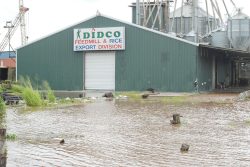(Trinidad Guardian) Plans are afoot to slash this country’s TT$4 billion food import bill in half by growing rice, corn, peas and beans on a large scale by 2012. Three Agricultural Society of T&T (ASTT) members, including its president Dhano Sookoo are now working feverishly on this plan. Nawiz Karim and Elizabeth Mohammed-Ali are the two other ASTT directors pushing for the boost to the agricultural sector.
Last Wednesday, the ASTT members met with a team from the Ministry of Food Production, Land and Marine Affairs to chart a new way forward for the agriculture sector. Key on the ASTT’s agenda is to resuscitate the flagging rice industry, help reduce the country’s food import bill and inflation, and conserve the environment. The move, ASTT member Richard Singh said, will serve to generate sustainable, productive employment, while creating “a food secure nation.” Singh, a grain expert who has travelled extensively abroad, said rice was the first of several crops that the ASTT had targeted to increase overall efficiency and productivity of the agricultural sector. They will be following closely with corn, then red bean, black eyed peas and lentils, which were never grown in T&T but has taken Guyana by storm.
Up to 2010, T&T imported 196,295 tonnes of staples and 10,680 tonnes of peas and beans, costing the Govern-ment hundreds of million of dollars. Once the two crops shoot off the ground, Singh said, this can help cut the country’s TT$4 billion food import bill in half. “This is our aim and it can be done.” Up to 1995, Singh said there were approximately 6,000 rice farmers, supplying the highly consumed staple to the National Flour Mills. At that time, Singh said, the country’s total paddy production was 21,200 metric tonnes, which was approximately 30 per cent of domestic demand.
But due to the high cost of production, little incentives offered and the sudden closure of the country’s lone rice mill in Carlsen Field in 2005, the vibrant farming community dwindled to a mere 20, as many farmers called it a day and moved on to new pursuits. There are currently 19 rice farmers in Caroni with one in Plum Mitan, Singh disclosed. “This figure is pathetic. It’s a far cry to the number of farmers we had before,” Singh added. To compound matters, Singh said when the industry started to go under, millions of dollars worth in heavy equipment such as harvesters, brush cutters and tractors went idle, which left a sour taste in the mouths of farmers.
Admitting that approximately 25,000 acres of private and state lands in Trinidad were sourced by the ASTT within the last few weeks to grow paddy, Singh was optimistic that with best farming and management practices, adequate labour, marketing strategy, machinery and Government’s agricultural incentive programmes, the move was achievable. “From this venture we can generate approximately 6,000 jobs in the next few years,” Singh disclosed. “There is a lot to be gained. This is just the start of things to come. There is so much we can do if we work together.” Singh said the plan was to ensure that all available agricultural lands are kept under con-stant production and help reduce food inflation. It was also hoped that people who left the agriculture sector would be encouraged to return. One of the biggest challenge, Singh said, was wooing old and new farmers to the land.
Seed stations get
an overhaul
Singh said he has already touched base with an Indian firm asking for a quotation on small, medium and large paddy harvesters, which he would receive shortly. “Within the next two weeks that information should be made available.” The prices of the equipment, Singh said, can range between TT$200,000 to TT$1 million, which will be subsidised by the ministry, under its new incentive programme. Singh said the ministry had expressed an interest in buying a foreign harvester to demonstrate to farmers how they can reduce cost, labour and time during harvesting on small and large farms.
“It’s all about going mechanised and getting away from being labour intensive.” Within the next few weeks, Singh said seed stations across the country will be transformed to serve the needs of farmers, many of whom used substandard seeds to grow crops. Singh said the stations were run to the ground over the years and needed a major overhaul. “This has to change if we are to move forward.” Another crop which has great potential to generate revenue for the country, Singh said, was corn. The cereal grain can be used as animal feed, for corn flour, corn syrup and corn oil to name a few.









